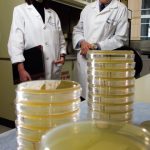Going Big Against Cancer
Read moreState: Texas
Sharon Lockhart, M.D.
Powel Brown, M.D., Ph.D.
Through these studies we hope to identify the transcription factors critical for the transformation of human breast cells, and to develop specific inhibitors of these transcription factors. Such transcription factor inhibitors may be novel therapeutic agents for the prevention and treatment of breast cancer.
Jason Fleming, M.D.
Funded by Papa John’s International
Navid Sadeghi, M.D., MS
Funded by Hooters of America, LLC
Fewer than 5% of adult cancer patients in the United States are enrolled in clinical trials. In addition, minorities constitute a small proportion of individuals participating in cancer studies. These strikingly low figures delay scientific advances, limit generalizability of trial results, and limit patient access to cutting-edge therapies. Proposed reasons for low accrual include lack of study availability, stringent eligibility criteria, physicians’ biases and lack of awareness, logistical issues, and patient mistrust.
Parkland Health and Hospital System (PHHS) serves as the safety-net hospital for Dallas County. Parkland, in partnership with the University of Texas Southwestern, provides medical care to a large population that disproportionately includes underserved minorities. Cancer patients presenting to Parkland are typically diagnosed at a more advanced stage and are more likely to have had delays in their care.
Based on our previous observations, we believe that the greatest potential impact lies in addressing specific and modifiable aspects of patient care. We therefore propose a Breast Cancer Clinical Research Navigator with a role distinct from research coordinators that will focus on early identification of trial candidates, expediting initial patient evaluation, and improving provider awareness of trial options.
We believe that engaging a Breast Cancer Clinical Research Navigator in the ways outlined above, will result in early and integrated consideration and presentation of trial options and will impact both patient and clinician interest in clinical trials, thereby augmenting accrual.
Robert Coleman, M.D.
Ovarian cancer is a devastating disease heightened by its tendency to present when metastatic disease is already present. Many women diagnosed with the disease complain that despite their best surveillance efforts, the disease occurred completely “under the radar.” While most women are symptomatic at diagnosis, the symptoms are veiled as common inconveniences of daily life, such as bloating, fullness and pelvic discomfort. Primary treatment involves a combination of surgery and chemotherapy. Tumor control is achieved in >75%. However, despite these early treatment gains, a typical patient will suffer recurrence within 2 years, where limited curative options exist. These clinical observations have fueled the search for better treatment agents and strategies. The unprecedented explosion of information arising from analyses of the cancer cell environment has directed new investigative opportunities. One such observation in line with this clinical story is the efficacy of agents that target new blood vessel formation. Several clinical trials with these agents in both initial and recurrent disease settings have demonstrated benefit to women. However, improvement in survival has not been realized. Our investigation into why this might occur has uncovered that the immune system may be adversely contributing. Of great concern, though, is that this process appears to be induced by the very drug being used for therapy. The current proposal tackles this issue by specifically investigating and targeting these immune cells. Our clinical trial design uniquely identifies patients where this “escape” effect may be at work. The translationally-rich proposal holds promise to substantially improve treatment outcomes.
Cullen Taniguchi, M.D., Ph.D.
2015 V Foundation Wine Celebration Vintner Grant in Honor of Rick and Elaine Jones With Support From Becky and Howard Young
Pancreatic cancer is an almost universally deadly disease because it spreads quickly to other organs (metastasizes) easily and there is no early detection mechanism. Surgery can be an effective treatment, but less than 10% of patients are diagnosed at a resectable stage. About 30% of patients with pancreatic cancer have locally advanced pancreatic cancer, where the cancer has not yet metastasized, but cannot be removed by surgery. The only way to kill locally advanced pancreatic cancer is with chemotherapy and radiation. Radiation therapy can kill any tumor but its therapeutic effects are limited by unavoidable damage to normal tissue near the cancerous target. For instance, adenocarcinomas of the pancreatic head require high doses of radiation to achieve tumor control, but these cannot be safely given to patient because the pancreas sits near a part of the small bowel called the duodenum, which is very sensitive to radiation damage. Thus, we can never give the amount of radiation needed to kill the tumor without causing undue harm to the duodenum (and the patient). My research will solve this problem by strengthening the duodenum and nearby tissues to withstand higher doses of radiation by activating the hypoxia-inducible factors (HIFs), which promote recovery from radiation treatments without protecting tumors. My published work has shown that HIF2 can reduce GI toxicity from radiation, and this proposal seeks to use this biology to make the duodenum more resistant to radiation toxicity to allow us to give higher doses of therapeutic radiation to the pancreatic tumors.
Wadih Arap, M.D., Ph.D., Renata Pasqualini, Ph.D.
David J. Tweardy, M.D., Michael T. Lewis, Ph.D., Mothaffar F. Rimawi, M.D.
We are proposing in this V Foundation Translational Grant application to continue to transition C188-9, a small-molecule inhibitor of the cancer-causing protein, Stat3, into an oral drug for use in treating patients with breast cancer and cancer cachexia. The target cancer is a subtype of breast cancer for which there currently are no available targeted therapies in the clinic i.e. breast cancers that do not express the estrogen receptor (ER-), the progesterone receptor (PR-) or the human epidermal growth factor receptor (HER) 2 receptor (HER2-). This subtype of breast cancer, often referred to as triple-negative breast cancer (TNBC), accounts for 20% of breast cancer, is characterized by an aggressive phenotype, is preferentially found in younger women and in African-American women, and has been associated with poor prognosis. Recent studies by us and others has demonstrated that Stat3 is activated in 70% of TNBC tested and that Stat3 activity makes a critical contribution to the growth of these tumors. Thus, Stat3 may be a key target in this subtype of breast cancer. We have developed the capability of testing C188-9 for its ability to inhibit the growth in mice of TNBC tumors that have been transplanted directly from patients. This capability allows us to determine accurately whether or not a patient with TNBC will respond to C188-9. Thus far, we have tested C188-9 in two TNBC patient-derived xenograft (TN-PDX) models in which activation of Stat3 was demonstrated. One TN-PDX model was resistant to standard chemotherapy (docetaxel), while the second TN-PDX model was sensitive to docetaxel. We observed a striking benefit in both models when C188-9 treatment was added to docetaxel. The docetaxel-resistant TN-PDX was converted to docetaxelsensitive by the addition of C188-9, while the docetaxel responsive TN-PDX demonstrated an improved tumor response by shrinking 4-fold further with the addition of C188-9. We have determined that C188-9 given by mouth at high doses is quite safe in mice, rats and dogs. C188-9 also reached high levels in the bloodstream and tumors borne by these animals with 2-fold higher levels being achieved in the tumors than in the bloodstream. As outlined in this proposal (Aim 1), we plan to perform an animal clinical trial using 23 TN-PDX models, and thereby learn the breadth of responses to C188-9 we can expect in patients with TNBC. This information will be very useful for designing clinical trials to test the effect of C188-9 in combination with docetaxel in TNBC patients. The animal clinical trial will also allow us to determine if reduction in the level of activated Stat3 in blood cells and in tumors can serve as a marker that we can follow in patients as evidence of successful targeting of Stat3 by C188-9.
Cachexia is the second clinical application for C188-9 that we are exploring in this proposal. Cachexia is the muscle wasting process causing progressive muscle weakness in nearly all patients with cancer. Cancer cachexia is a major cause of morbidity and reduced quality of life in patients with cancer, including breast cancer, and it directly causes up to 25% of all cancer deaths. We recently demonstrated that cachexia in cancer involves a signaling pathway within skeletal muscles that links Stat3 activation with upregulation of myostatin, a hormone that serves as the major negative regulator of muscle mass. Targeting myostatin in mouse models of cancer cachexia not only reversed cachexia but also improved survival despite continued growth of tumor. However, patients with cachexia who have been treated with direct myostatin inhibitors developed unexplained bleeding, which has halted further testing of this approach. We demonstrated that C188-9 treatment of mice with tumors that cause cachexia prevents activation of Stat3 within their skeletal muscles. Consequently, levels of myostatin were not increased and muscle wasting was prevented. Importantly, treatment with C188-9 did not cause any ill effects in mice. In fact, tumor-bearing mice treated with C188-9 gained weight and maintained muscle strength. One of the goals of the clinical trials outlined in Aim 2 of this proposal is to begin to determine if C188-9 treatment of patients with TNBC prevents them from developing muscle loss, weakness, and/or fatigue.
The successful completion of the studies outlined in this proposal will provide additional strong support for the overarching concept that C188-9 can be used safely and effectively as an oral agent to treat patients with breast cancer, particularly TNBC, in combination with standard chemotherapy to improve therapeutic responses, as well as to prevent cancer cachexia.










